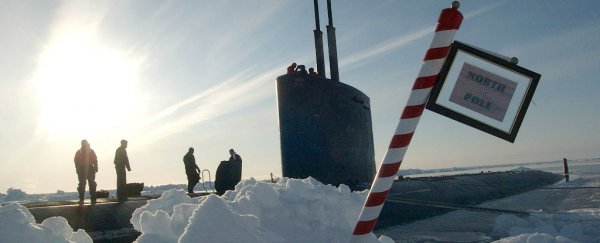Earth's North Pole has never been as stable as it looks on maps, with the planet wobbling slightly as it spins on its axis, and causing the poles to gradually drift.
But 15 years ago - around the turn of millennium - the pole mysteriously switched direction and starting heading east towards the Greenwich meridian at almost twice its previous speed. And now NASA scientists have finally figured out why.
For the better part of the 1900s, the physical North Pole was moving westwards around 10 cm each year towards Canada's Hudson Bay. But in 2000, it shifted direction 75 degrees eastwards and started moving east at a rate of around 17 cm annually, an unprecedented and unexpected move.
"It's no longer moving toward Hudson Bay, but instead toward the British Isles," said one of the researchers, Surendara Adhikari from NASA's Jet Propulsion Laboratory. "That's a massive swing."
But if the knowledge that the North Pole is gradually moving towards London is surprising, perhaps slightly less shocking is what's behind the shift - after studying satellite data, the NASA team found that humans are pretty much to blame, due to our influence on the planet's water content.
Adhikari and co-researcher Erik Ivins used data from NASA's GRACE satellites to see whether water mass across the planet was related to Earth's spin axis, and found an incredibly strong link.
In fact, the influence was so large that when they used the changes in land water mass to predict the positions of the North and South Pole between 2003 and 2015, the results perfectly lined up with the real data.
"This is much more than a simple correlation," said Ivins. "We have isolated the cause."
Before this, it was assumed that water was playing a role in some way, but most of the blame was put on climate change and the melting of the Greenland Ice Sheet.
But Adhikari and Ivins showed that the changes in Greenland alone weren't generating enough energy to pull Earth's spin axis so far to the east.
They calculated that something east of Greenland had to be exerting an extra pull to move the North Pole as much as it had - and that something was happening in Eurasia.
"The bulk of the answer is a deficit of water in Eurasia," said Adhikari. "The Indian subcontinent and the Caspian Sea area."
The water loss in this region between Europe and Asia doesn't even come close to the changes happening up at the Arctic ice sheets. But the team found that the spin axis is particularly sensitive to changes occurring around 45 degrees latitude - both north and south - which is why the changes in India, for example, are so important.
The good news is that the Earth's wobble doesn't really affect our daily lives at all - and as far as we know, the furthest Earth's North Pole has ever moved is 12 metres (37 feet). But we do have to take into account the shifting poles to make sure GPS is accurate, and this model will help us do that.
Not only that, but finally knowing what is controlling the direction and movement of the poles means we will now have more insight into the water content of Earth in the past, and can begin to predict the poles' movements well into the future.
The research has been published in Scientific Advances.
